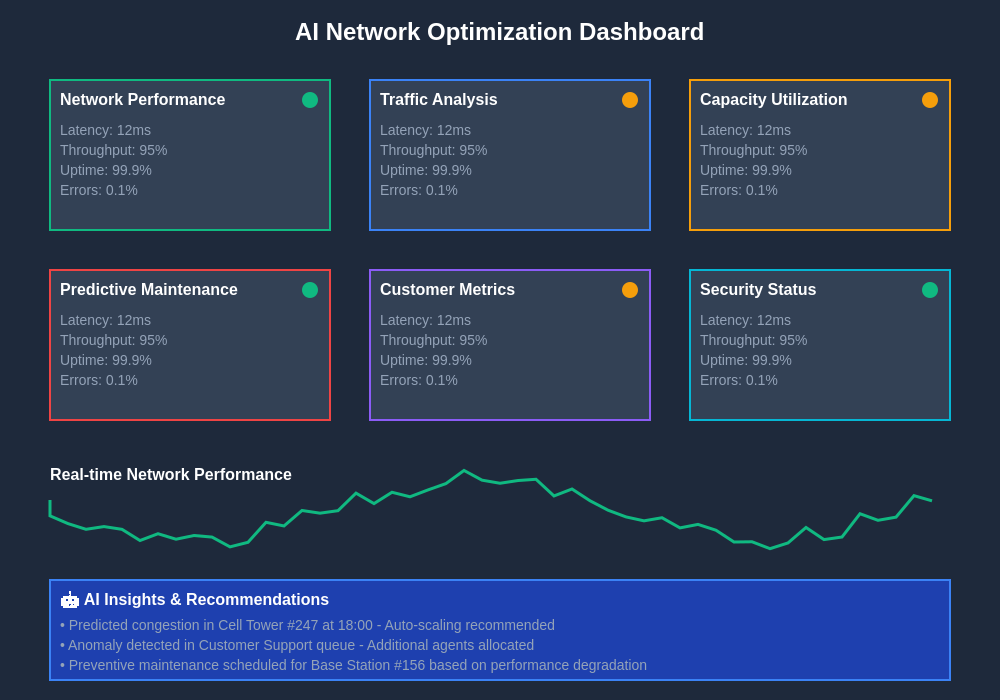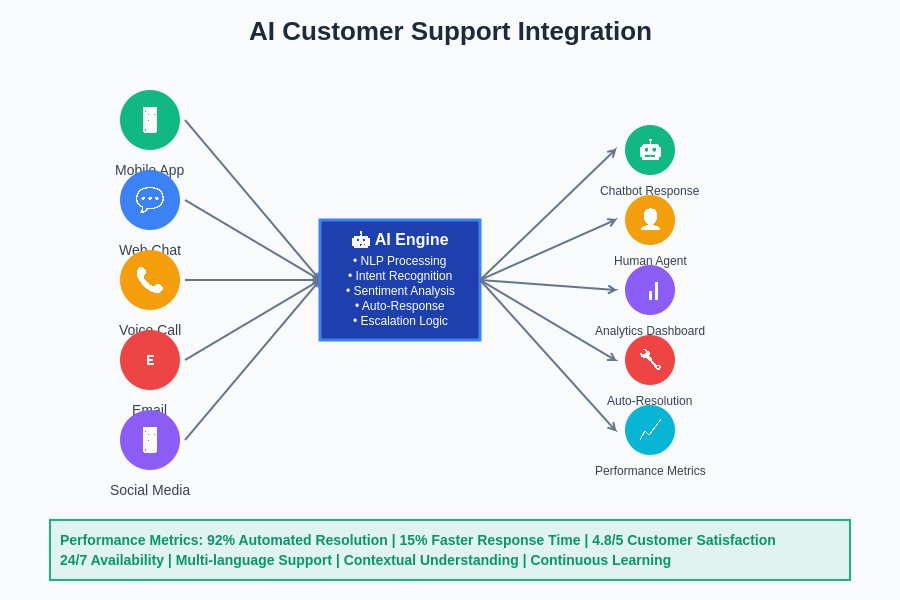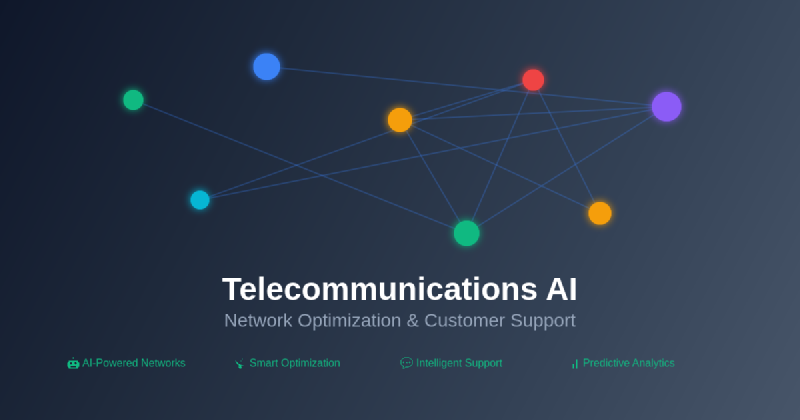The telecommunications industry stands at the precipice of a technological revolution, where artificial intelligence has emerged as the cornerstone of modern network infrastructure and customer service excellence. As global data consumption continues to surge exponentially and customer expectations reach unprecedented heights, telecommunications providers are increasingly turning to sophisticated AI solutions to optimize network performance, enhance service delivery, and create more responsive customer support ecosystems that can adapt to the dynamic demands of the digital age.
Explore the latest AI innovations in telecommunications to understand how cutting-edge technologies are reshaping the connectivity landscape and driving the next generation of communication infrastructure. The integration of AI into telecommunications represents a fundamental shift from reactive network management to proactive, intelligent systems that can anticipate problems before they occur and optimize performance in real-time.
The Evolution of AI-Driven Telecommunications
The telecommunications sector has undergone dramatic transformation over the past decade, evolving from simple voice communication networks to complex, multi-layered infrastructure systems that support everything from high-definition video streaming to Internet of Things devices and autonomous vehicle communications. This evolution has created unprecedented complexity in network management, requiring sophisticated solutions that can handle massive data volumes, diverse traffic patterns, and stringent performance requirements across multiple service tiers.
Artificial intelligence has emerged as the enabling technology that makes this complexity manageable, providing telecommunications companies with the tools necessary to optimize network resources, predict maintenance needs, and deliver personalized customer experiences at scale. The application of machine learning algorithms, deep neural networks, and advanced analytics has transformed how telecommunications providers approach everything from spectrum allocation to customer relationship management, creating more efficient, reliable, and responsive communication networks.
The convergence of AI with telecommunications infrastructure has resulted in smart networks that can self-optimize, self-heal, and self-configure based on real-time conditions and historical patterns. This autonomous network management capability has become essential as telecommunications providers deploy 5G networks, edge computing infrastructure, and support an ever-expanding ecosystem of connected devices that demand consistent, high-quality connectivity.
Network Optimization Through Intelligent Algorithms
Network optimization represents one of the most critical applications of AI in telecommunications, where machine learning algorithms continuously analyze traffic patterns, bandwidth utilization, and performance metrics to make real-time adjustments that maximize network efficiency and user experience. These intelligent systems can process vast amounts of network data to identify optimization opportunities that would be impossible for human operators to detect and implement manually.
Advanced AI algorithms excel at dynamic load balancing, automatically redistributing network traffic across available resources to prevent congestion and maintain optimal performance levels during peak usage periods. The systems can predict traffic surges based on historical data, seasonal patterns, and real-time indicators, allowing networks to proactively allocate resources and adjust configurations before performance degradation occurs.
Machine learning models have proven particularly effective at optimizing radio frequency spectrum allocation in wireless networks, where AI systems can analyze interference patterns, user density, and application requirements to dynamically assign spectrum resources that maximize overall network capacity and minimize service disruptions. This intelligent spectrum management becomes increasingly important as telecommunications providers deploy dense urban networks and support diverse use cases with varying performance requirements.
Leverage advanced AI capabilities with Claude for telecommunications analysis and optimization strategies that can help network operators implement intelligent solutions for complex infrastructure challenges. The combination of human expertise and AI-powered analysis creates powerful optimization strategies that improve network performance while reducing operational costs.
Predictive Maintenance and Infrastructure Management
The implementation of predictive maintenance systems powered by AI has revolutionized how telecommunications companies manage their extensive infrastructure networks, transforming maintenance operations from reactive repair models to proactive prevention strategies that minimize service disruptions and extend equipment lifecycle. These sophisticated systems continuously monitor network equipment health, analyzing performance metrics, environmental conditions, and historical failure patterns to predict when maintenance interventions will be required.
AI-driven predictive maintenance systems utilize advanced sensor data, network performance indicators, and machine learning algorithms to identify subtle changes in equipment behavior that precede failures, enabling maintenance teams to schedule interventions during low-traffic periods and avoid unexpected outages that can affect thousands of customers. The financial benefits of this approach are substantial, as proactive maintenance typically costs significantly less than emergency repairs and helps telecommunications providers maintain higher service level agreements.
The integration of Internet of Things sensors with AI analytics has enabled comprehensive monitoring of telecommunications infrastructure, from cell towers and base stations to fiber optic cables and data center equipment. These systems can detect anomalies in temperature, vibration, power consumption, and signal quality that indicate potential problems, allowing maintenance teams to address issues before they impact service quality or cause complete equipment failures.
Intelligent Customer Support Systems
Customer support in the telecommunications industry has been fundamentally transformed through the implementation of AI-powered systems that can handle complex inquiries, resolve technical issues, and provide personalized assistance at scale. These intelligent support systems combine natural language processing, machine learning, and comprehensive knowledge bases to deliver customer service experiences that rival human agents while providing 24/7 availability and consistent service quality.
Modern AI customer support platforms can understand and respond to customer inquiries across multiple channels, including voice calls, text messages, web chat, and social media interactions, providing seamless omnichannel experiences that maintain conversation context regardless of how customers choose to communicate. The systems can analyze customer sentiment, identify urgent issues that require immediate attention, and escalate complex problems to human agents with complete interaction history and suggested resolution strategies.
The implementation of intelligent virtual assistants has enabled telecommunications companies to handle routine inquiries such as billing questions, service changes, and technical troubleshooting without human intervention, freeing customer service representatives to focus on complex issues that require creative problem-solving and emotional intelligence. These AI systems continuously learn from successful resolution patterns and customer feedback to improve their effectiveness over time.

The comprehensive monitoring and optimization of telecommunications networks requires sophisticated dashboard systems that can present complex performance data in intuitive formats that enable quick decision-making and proactive network management. These AI-powered interfaces provide real-time visibility into network health, capacity utilization, and performance trends across multiple network segments and service tiers.
Advanced Traffic Management and Quality of Service
Traffic management in modern telecommunications networks requires sophisticated AI systems that can analyze data flows, application requirements, and user behavior patterns to implement intelligent quality of service policies that ensure optimal performance for critical applications while efficiently utilizing available network resources. These systems must balance competing demands from different types of traffic while maintaining fair access and meeting service level commitments.
AI-powered traffic management systems excel at identifying and prioritizing different types of network traffic based on application requirements, user preferences, and business policies. The systems can distinguish between latency-sensitive applications like video conferencing and voice calls versus bandwidth-intensive but delay-tolerant applications like file downloads or software updates, automatically adjusting routing and resource allocation to optimize overall user experience.
The implementation of machine learning algorithms for congestion control has enabled telecommunications networks to respond more intelligently to traffic surges and capacity constraints, implementing dynamic throttling and rerouting strategies that maintain acceptable performance levels even during peak usage periods. These systems can learn from historical congestion patterns to predict and prevent network bottlenecks before they impact user experience.
Enhance your research capabilities with Perplexity to stay informed about the latest developments in telecommunications AI and network optimization technologies that are shaping the future of global communications infrastructure. Access to comprehensive research resources enables telecommunications professionals to make informed decisions about AI implementation strategies.
5G Network Management and Optimization
The deployment of 5G networks has created new opportunities and challenges for AI-powered network management, where the increased complexity of network slicing, edge computing integration, and ultra-low latency requirements demand sophisticated artificial intelligence systems that can manage resources and optimize performance across multiple service tiers simultaneously. These next-generation networks rely heavily on AI to deliver the promised performance benefits and support diverse use cases.
AI systems in 5G networks must manage dynamic network slicing that creates virtual networks optimized for specific applications or customer segments, automatically allocating resources based on service requirements, traffic patterns, and performance objectives. The complexity of coordinating multiple network slices while maintaining isolation and meeting performance guarantees requires advanced machine learning algorithms that can optimize resource allocation in real-time.
The integration of edge computing with 5G networks has created additional optimization opportunities where AI systems can determine optimal placement of computing resources, manage workload distribution between edge and cloud infrastructure, and optimize data routing to minimize latency and maximize application performance. These decisions must be made continuously as network conditions and application requirements change throughout the day.
Fraud Detection and Security Enhancement
Telecommunications networks face constant security threats and fraudulent activities that can result in significant financial losses and service disruptions, making AI-powered security systems essential components of modern network infrastructure. These intelligent security systems can analyze network traffic patterns, user behavior, and transaction data to identify suspicious activities and potential security breaches in real-time.
Machine learning algorithms excel at detecting anomalous behavior patterns that may indicate fraudulent activities such as SIM card cloning, unauthorized access attempts, or unusual calling patterns that suggest account compromise. The systems can learn from historical fraud patterns and adapt to new attack methods, providing dynamic protection that evolves with emerging threats.
The implementation of AI-powered security monitoring has enabled telecommunications providers to identify and respond to distributed denial of service attacks, network intrusions, and other security incidents much faster than traditional security systems, minimizing the impact on network performance and customer service. These systems can automatically implement defensive measures while alerting security teams to investigate potential threats.

The modern customer support ecosystem in telecommunications relies heavily on AI-powered systems that can handle multiple communication channels, understand customer intent, and provide personalized assistance while maintaining comprehensive interaction histories and performance analytics. This integrated approach ensures consistent service quality across all customer touchpoints while enabling intelligent escalation and resolution strategies.
Revenue Optimization and Business Intelligence
AI applications in telecommunications extend beyond operational efficiency to encompass revenue optimization and strategic business intelligence that help companies identify new market opportunities, optimize pricing strategies, and improve customer lifetime value through data-driven insights and predictive analytics. These systems analyze customer behavior, market trends, and competitive dynamics to inform business decisions and drive growth.
Advanced analytics platforms can identify customer segments with high churn risk, enabling telecommunications providers to implement targeted retention strategies before customers actually leave for competitors. The systems can analyze usage patterns, payment history, customer service interactions, and external factors to predict which customers are most likely to cancel their services and recommend specific interventions that have proven effective for similar customer profiles.
The implementation of dynamic pricing algorithms has enabled telecommunications companies to optimize their pricing strategies based on demand patterns, competitive positioning, and customer willingness to pay, maximizing revenue while maintaining market competitiveness. These AI systems can adjust pricing recommendations in real-time based on market conditions and customer behavior patterns.
Internet of Things Integration and Management
The proliferation of Internet of Things devices has created new challenges and opportunities for telecommunications providers, where AI systems must manage connectivity for millions of devices with diverse communication patterns, power constraints, and data transmission requirements. These systems must optimize network resources to support massive IoT deployments while maintaining quality of service for traditional communications.
AI-powered IoT management platforms can automatically configure network parameters for different device types, implement power-saving protocols for battery-operated sensors, and optimize data routing to minimize network congestion while ensuring reliable connectivity for critical IoT applications. The systems can learn from device behavior patterns to predict maintenance needs and optimize battery life for sensor networks.
The integration of edge computing with IoT networks has created opportunities for AI systems to process IoT data locally, reducing bandwidth requirements and improving response times for time-sensitive applications. These intelligent edge systems can filter and aggregate sensor data before transmitting summary information to cloud platforms, optimizing network utilization and reducing data storage costs.
Future Innovations and Industry Transformation
The continued evolution of AI technologies promises to bring even more sophisticated capabilities to telecommunications networks, with emerging technologies such as quantum computing, advanced neural networks, and autonomous systems creating new possibilities for network optimization, customer service, and business operations. These future innovations will further transform how telecommunications companies deliver services and manage infrastructure.
The development of fully autonomous networks that can self-configure, self-optimize, and self-heal without human intervention represents a significant goal for the telecommunications industry, where AI systems would handle all aspects of network management from initial deployment through ongoing optimization and maintenance. These systems would continuously adapt to changing conditions and requirements without manual oversight.
The integration of artificial intelligence with emerging technologies such as satellite networks, quantum communications, and advanced wireless protocols will create new opportunities for telecommunications providers to offer innovative services and support applications that are not possible with current technology limitations. The combination of AI and next-generation communications technologies will enable new business models and service offerings that transform how people and organizations communicate and collaborate.

The measurement and analysis of AI system performance in telecommunications requires comprehensive metrics that evaluate network optimization effectiveness, customer satisfaction improvements, and operational efficiency gains across multiple dimensions of service delivery and infrastructure management. These performance indicators demonstrate the tangible benefits of AI implementation across all aspects of telecommunications operations.
Implementation Strategies and Best Practices
Successful implementation of AI systems in telecommunications requires careful planning, comprehensive data integration, and phased deployment strategies that minimize disruption to existing services while maximizing the benefits of intelligent automation. Telecommunications companies must develop clear implementation roadmaps that align AI initiatives with business objectives and technical capabilities.
The integration of AI systems with existing network infrastructure requires careful consideration of data quality, system compatibility, and performance requirements to ensure that intelligent systems can access the information they need to make effective optimization decisions. Companies must invest in data collection, storage, and processing infrastructure that can support AI applications while maintaining security and privacy requirements.
Training and change management programs are essential components of successful AI implementation in telecommunications, where technical staff must develop new skills and adapt to working with intelligent systems that automate many traditional network management tasks. Organizations must balance automation benefits with the need to maintain human expertise for complex problem-solving and strategic decision-making.
The measurement of AI system performance and return on investment requires comprehensive metrics that evaluate both technical performance improvements and business impact across multiple dimensions of telecommunications operations. Companies must establish baseline performance measurements and track improvements in network efficiency, customer satisfaction, operational costs, and service quality to demonstrate the value of AI investments.
Disclaimer
This article is for informational purposes only and does not constitute professional advice. The views expressed are based on current understanding of AI technologies and their applications in telecommunications. Readers should conduct their own research and consider their specific requirements when implementing AI-powered telecommunications solutions. The effectiveness of AI systems may vary depending on specific network configurations, customer requirements, and implementation approaches.
